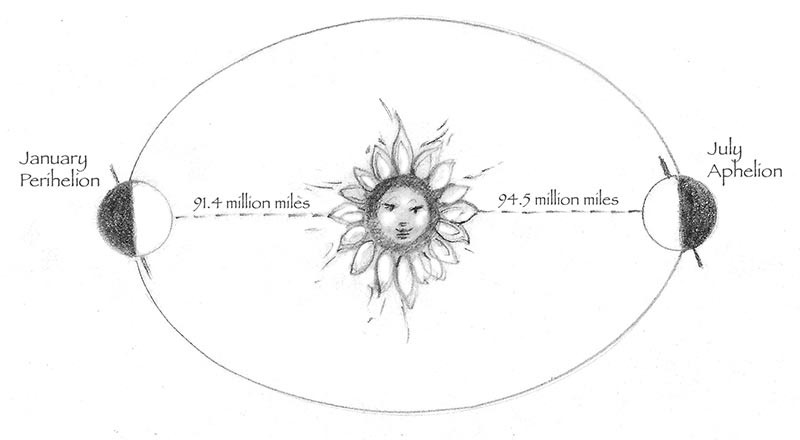
Few things seem as remote as the January sun in northern New England. We see the light, but we feel almost no heat. In this way, winter can feel like a kind of exile – there’s a sense that the Earth has been flung to the farthest reaches of its orbit.
The idea that the winter sun is remote, however, is misguided. In fact, the Earth is closest to the sun when the Northern Hemisphere is in the deep freeze of winter. This extreme proximity is known as perihelion, and in 2019 it will take place on January 3. Conversely, aphelion – when the Earth is farthest from the sun – takes place during the height of summer, this year on the Fourth of July. The exact dates vary slightly every year, but always occur in January and July.
The seasons, of course, are dictated by the tilt of the Earth as it orbits the sun. Our planet’s constant 23.5-degree angle causes the Northern and Southern Hemispheres to alternate being oriented towards and away from the sun. During these short, cold days of the New England winter, the north is oriented away from the sun, so its rays hit us at an indirect angle, generating less heat and fewer hours of daylight.
But knowing that the seasons are the result of the Earth’s axis of rotation never stopped me from assuming that our planet’s proximity to the sun also plays into the equation. It doesn’t, which is surprising given the difference in Earth’s distance from the sun between perihelion and aphelion is about three million miles. From an earthbound perspective, that’s a lot of miles: the equivalent of driving from Burlington, Vermont, to Miami, Florida, and back 1,000 times.
Perihelion and aphelion, however, are not earthbound phenomena, and in astronomical terms three million miles isn’t all that far. On January 3, the Earth will be 91,403,550 miles from the sun; on the Fourth of July, the distance grows to 94,513,225 miles, only a 3.1 percent change.
But the shifting proximity between Earth and sun is not without earthly impact. According to NASA, when we are closest to the sun, the average sunlight hitting the planet is about seven percent greater than it is at aphelion in July. We don’t really notice because the Southern Hemisphere is better equipped to deal with it. Land absorbs more heat than water, and the Southern Hemisphere has more water than land. So even though it is receiving more light during its summer than the Northern Hemisphere, it has less land mass to capture and retain the heat. Consequently, on average, a Vermont summer is warmer than summer in say, Sydney, Australia.
Not only does the Northern Hemisphere absorb more heat than its southern counterpart, but the summers here are longer. That’s because at aphelion “there is slightly less gravitational force from the sun in our summer (Southern Hemisphere’s winter), so the Earth moves a little slower in its orbit, lengthening the season,” said Mark Breen, senior meteorologist at the Fairbanks Museum and Planetarium. “We are closer to the sun in winter, increasing the gravitational effects of the sun, increasing our orbital speed, and lessening the number of days of winter.” While it may not always seem so, we Northerners experience about 94 days of summer, but only 89 days of winter.
So as winter marches on, I look forward to Earth swinging ever farther from the sun until the Fourth of July, when it can go no farther. I will also do my best to enjoy the beauty of the Northern New England winter; after all – in relative terms, at least – it’s not that long.


Discussion *